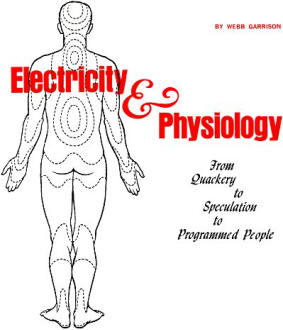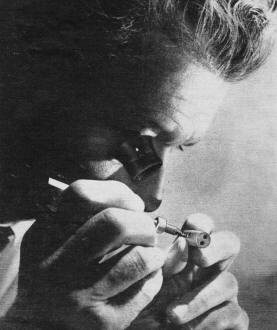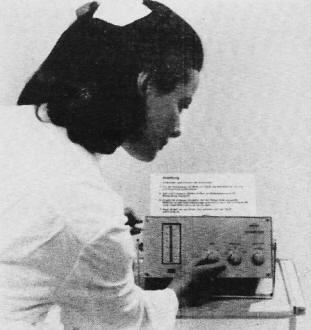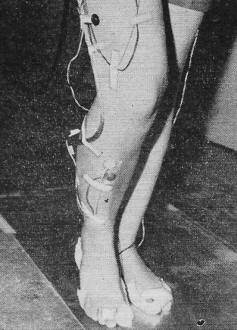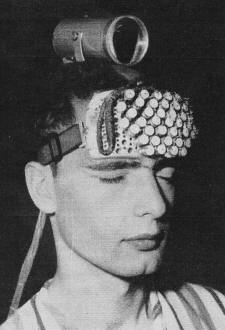Electricity & Physiology
|
|
The subtitle of this article from a 1971 issue of Popular Electronics, "From Quackery to Speculation to Programmed People," could to some extent still be applicable even though the author evidently meant to put an end to the "quackery" and "speculation" part of it. Indeed, a lot of advancement has been made in the fields of electrostimulation of weak or/or paralyzed muscles, healing of certain types of soft and hard tissues, suppressing sporadic muscle twitching and epileptic seizures, and other malady diagnosis and relief. Specifically tuned microwave frequencies have proven useful in healing and symptom relief as well. As with most articles on medical procedures, I cringe at some of the photos, like the "skin tunnel transformer" where an implanted subcutaneous coil is encased in skin to allow an inductive clamp to be hooked around it. Techniques used in wireless charging applications have probably replaced such methods. Even modern medical equipment can sometimes cause pain or discomfort to the unfortunate (but fortunate) recipients of the most leading edge treatment. Electricity & Physiology
By Webb Garrison From Quackery to Speculation to Programmed People Thirty or forty years ago, few scientists who valued their reputations dabbled with far-out uses of electricity. Before the scientific viewpoint (which requires results that can be repeated) took hold, dabblers in physics and chemistry and medicine had all sorts of odd-ball notions about electricity. So many different kinds of electrical treatments and cures were tried by eager amateurs and outright quacks that for 125 years after the death of Franz Mesmer in 1815, all ideas about electricity in the human body were suspect. Within the past few months, Dr. Robert O. Becker, Chief of Staff for Research at the Veterans Administration Hospital, Syracuse, New York has predicted that within 20-30 years it will be possible to grow new parts of the human body to replace those lost as a result of injury or surgery by means of electricity! (The diagram of the body above, developed by Dr. Becker, shows what are known as the slow dc systems in the body.) Dr. James Zimmerman adjusts his Superconducting Quantum Interference Device (SQUID) a transducer he invented to monitor electrical activity in the body. It permits external monitoring by means of the measurable fields. (NBS photograph.) Animal studies already under way have produced startling results. By stimulating cells with minute electrical charges, Dr. Becker and his colleagues have caused these cells to produce masses of blastocytes - the initial building blocks of the human body. Controlled growth of human tissue and bone, including limb regeneration, might prove far more fruitful than transplantation of organs. Hints that electricity could be the force behind regeneration of bodily parts was first noticed in the mid-1940's. That's when repeated trauma brought about regeneration of a limb in an adult frog. A localized electrical field - produced by trauma - acted on target cells in such a fashion that the cells were stimulated to form blastocytes which developed into a new limb. Some creatures - notably salamanders-naturally regenerate lost parts. All known mammals do not. Dr. Becker thinks that the evolutionary processes have concentrated electrical activity in the brain and central nervous system and that mammals now lack the ability to produce electricity vital to the regeneration of bodily parts. All the necessary cells are there, but the required energy is not. Although some fellow scientists scoff at Dr. Becker's ideas, there is a surge of fresh interest in bioelectricity and biomagnetism. Basic to Life. Wherever there is life, you will find electricity. The electrical effects are as pervasive and essential as chemical reactions once thought to hold all answers to all riddles about the organization and operation of living things. The minute bones of your inner ear respond to every change of position with respect to gravity and send tiny pulses of electrical current to somehow inform the brain about every change in your orientation. Your eyes not only require electricity; they are so incredibly sensitive that hardly anything was known about electrical currents in the eyes until sophisticated electronic measuring devices were developed in the past decade. As your eyes trace this line of type, you trigger reactions that can be measured in terms of the evoked potentials at your scalp. A brain wave monitor - already operational - can feed these electrical signals into a computer that has been programmed to determine what color you are seeing at the moment. The German "Dormed" electro-therapeutic sleep inducer is not available in the USA. It generates 12-to-200 Hz square waves (15 V at 3 mA) which are applied to the patient's temples and forehead. (Photo courtesy the Robert Bosch Corporation.) The electroencephalogram (EEG), or tracing of brain waves, has been in use since the 1930's. Measuring devices for EEG are still in the process of refinement, primarily because we are dealing with very low frequencies (0.5-50 Hz) and minute voltages (0.401 - 0.402 volts). Today, measurement of brain waves is just a start towards full-scale electrical analysis of what goes on inside your head and body. Electrocardiographic (EKG) tracings reveal some of the things happening in the heart. Skin galvanometers record changes in potential at the surface of your body. Other instruments provide a record of eye movements - including duration and intensity of dreams. Electromyograms depict velocity and intensity of muscular contractions. Varied Processes. Your body is a beehive of electrical activity and has built-in generators, transmission systems, receptors, and even biological rheostats. There is growing evidence that the body has a reasonably well defined dc system for transmission of "large" amounts of current. However, most electrical activity takes place at the level of the individual cell. At the Institute for Enzyme Research of the University of Wisconsin, Dr. David E. Green has been studying the mechanism by which charged particles, or ions, are transported across cell membranes by donut-shaped carriers, or ionophores. These potassium or sodium ions are retained by an electro-chemical potential gradient; when the membranes are de-energized, the ions are released. Viewed under the electron microscope, physical changes in the membranes are clearly visible. Enzymes serve as catalytic agents to speed up chemical reactions without themselves being affected. No one knows for sure how many different enzymes your body includes, but an educated guess places the number at about 10,000. Until 1970, no one knew why enzymes function, but at the University of California in Berkley, Dr. Daniel E. Koshland, Jr. has shown that enzyme activity is electrical. It now appears that every enzyme in your body is a mini-micro electronic pilot. At the atomic level it maneuvers "orbital steering" of components and hastens their combination. This catalytic process of nature may be as much as 1,000,000 times as fast as catalytic processes employed in industry. Each enzyme is specific for a particular set of atoms. To achieve an "electrical" coupling, Dr. S. R. Topaz perfected a skin tunnel transformer that eliminates chance of irritation and infection. The coaxial cable (note size) feeds in energy and it also permits data to be readout. Deprive your body of enzymes that guide the atoms together, of cell membranes that are self-adjusting to permit two-way flow of charge particles, or the electrical pulses that keep your heart working and you'd be like an elaborate machine with the power switches pulled open. To Cure and to Kill. Luigi Galvani discovered that electric current can cause the muscles of a dead frog to twitch. This pioneer finding, made in 1791, established a rough relationship between electricity and magnetism and self-styled healers had a field day using magnets to "draw illness from the body." Quacks devised a variety of instruments guaranteed to cure anything from gout to consumption. This movement reached a peak in the era when Mesmer developed the art first called mesmerism and later hypnosis. Because so many phonies and rogues dabbled with electricity and magnetism in futile To achieve an "electrical" efforts to work miraculous cures, reputable scientists turned their backs on all attempts to use these forces in healing.* Rival of Drugs. Properly applied, electricity will do some things better than any known drug or chemical. This fast growing rival is at the interface where biology, chemistry and electronics intermingle. Electroconvulsive shock (ECS) has been used in the treatment of psychiatric disorders. ECS works with many patients - but not with all. The amnesia-producing effects of ECS are difficult to produce in some patients. Just why ECS works at all is not wholly understood, but most theories suggest that taking just the right amount of current and applying it in the proper fashion at the right time interferes with the consolidation of "memory traces." European psychiatrists and others have been experimenting with electrosleep therapy and reporting good results. In the United States the medical profession apparently believes that investigation into possible side effects on nerve centers, pituitary glands, and enzymatic systems through the introduction of an electrical current into the brain has not gone far enough. The National Research Council of Canada is investigating the electrical impulses that activate the leg musculature when walking. Data is computer programmed. At the University of Texas Medical School, Dr. Saul H. Rosenthal and colleagues have announced some astonishing results from low-intensity electrostimulation of the brain. Tested on a group of insomnia sufferers, there appear to be no side effects; and although sleep was not induced, the patients relaxed and then slept better at night. Individual treatments usually last for half an hour. The equipment used by Dr. Rosenthal produces a squarewave of one millisecond's duration at a rate of 100 Hz. The current yield is less than 1.2 mA. The report indicates that after as few as two or three treatments, some habitual users of sleeping drugs have found themselves able to go to sleep without barbiturates. It is now considered possible that electro-anesthesia may become an important adjunct to the battery of chemical compounds now used in operating rooms to shield patients from the pain of the surgeon's scalpel. Tests made by anesthesiologists from the Indian Army suggest that sine waves between 1200-1500 Hz help maintain a surgically satisfactory state of anesthesia for operations ranging from simple tonsillectomies to complicated internal surgery. But here too, many U.S. physicians brush away reports of electroanesthesia as pure unadulterated nonsense. Electrical Stimulation. Although electrosleep and electroanesthesia are frowned upon in the U.S., it is an entirely different ball game in the case of electrical stimulation of both muscles and brain cells. Implanted peripheral nerve stimulators have already proved highly effective. Using these devices, therapists seek to put into the body electricity needed for particular functions and usually provided for biologically under normal circumstances. Most persons who have received peripheral implants are victims of strokes, cerebral palsy, or similar disabilities. A few have even suffered spinal cord injuries. Electricity fed into the body is used to stimulate peripheral nerves so that muscles will contract at appropriate times. The complexity of "normal activities" is incredible as indicated by work in progress at various Canadian research centers. One such program is attempting to analyze precisely the characteristics and timing of the human gait. It is hoped that a computer-programmed input system will eventually enable paralyzed persons to walk by synchronized stimulation of the nerves involved. Experiments involving electrical stimulation of the brain (ESB) have been in progress for several decades. Use of miniaturized radio receivers have given patients complete mobility. In addition, Dr. Steven R. Topaz and colleagues have developed a "skin tunnel" transformer that permits efficient coupling, but eliminates the problem of irritation and infection. Once a skin tunnel transformer has been implanted, it can be used to transmit energy into the body and simultaneously permit readout of telemetry data regarding the electrical processes within the patient's body. Respiratory rate, heartbeat, gastric secretions, and many other bodily functions can be absolutely controlled by ESB. Sight is replaced by touch in the "Elektroftalm" recently developed in Poland. Image is scanned by photoelectric camera atop blind patient's head and "displayed" on forehead. Vision is rudimentary. Electronic Vision. A crude, but functional method of electronic vision for the blind is the most ambitious and elaborate project presently involving the use of electricity applied to the body from the outside. At the University of London, a self-taught expert in electronics has constructed an elaborate implant consisting of 80 individual radio receivers wrapped in silicone and placed under the scalp of a blind nurse. Radio signals activate the implanted receivers - singly or in groups - causing corresponding electrode stimulators to feed minute voltages to the surface of the nurse's brain. It has been demonstrated by Dr. Giles S. Brindley that this system creates the impression of perceived light. Eventually, Dr. Brindley hopes to give patients an elementary electronic vision, in which all of the optical systems used in normal vision are bypassed. Polish researchers have taken a different path. Sight is replaced by touch, a usually highly sensitive effect in blind people. Developed by Dr. Witold Starkiewiez and Wiktor Kuprianowicz the device uses a camera, photocells and a system of 60 tiny stimulators. Objects seen through the camera are scanned and displayed on the patient's skin. All researchers working in the area of electronic vision report that the blind will "see" within two decades. In all probability, one or more of several highly sophisticated systems will give functional sight to most blind people. From the cardiac pacemaker to nerve stimulators, electricity is the key to much of tomorrow's medicine. However, is it not also possible that, by the use of implanted electrodes, some future super-dictator will make electronic slaves of the human race? Instrumentation for such a system is practically within our grasp. Only time will tell whether the wonders of electricity will be used to liberate man from his handicaps or to create nightmares of the future. *Strangely enough, the electricity applied to the human body found its first significant triumph in the taking of a life. William Kemmler, convicted of murder, was sentenced to death by means of electrocution. Publicity about the impending execution attracted rival bids for the job of making the first "electric" chair. In the competition, a plan involving use of ac won out over Thomas Edison's dc system. Edison had insisted that ac was too dangerous for use in the ordinary American household. But when Kemmler was hit by 1700 volts on August 6, 1890, he began to revive a few moments after having been pronounced dead. After two more lengthy shocks - while one reporter fainted - the killer succumbed. When the public got over its indignation at so barbaric a manner of execution, opinion swung toward the use of ac for home use!
Posted December 20, 2018 |
|

